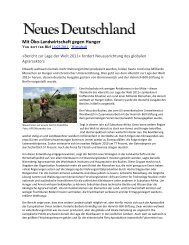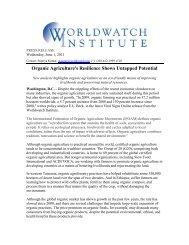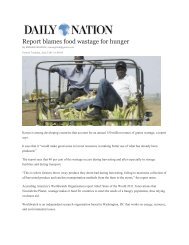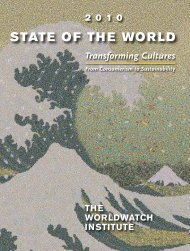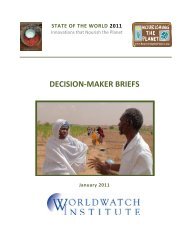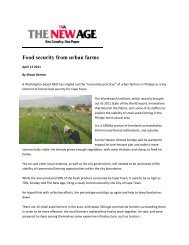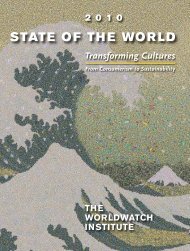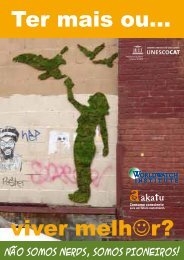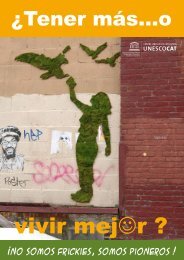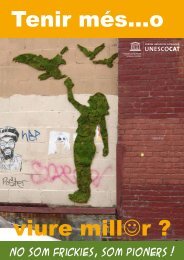Early Childhood Education to Transform Cultures for Sustainability
Early Childhood Education to Transform Cultures for Sustainability
Early Childhood Education to Transform Cultures for Sustainability
You also want an ePaper? Increase the reach of your titles
YUMPU automatically turns print PDFs into web optimized ePapers that Google loves.
STATE OF THE WORLD 2010 <strong>Early</strong> <strong>Childhood</strong> <strong>Education</strong> <strong>to</strong> <strong>Trans<strong>for</strong>m</strong> <strong>Cultures</strong> <strong>for</strong> <strong>Sustainability</strong><br />
tralia, <strong>for</strong> example, children have numerous<br />
opportunities <strong>to</strong> act as agents of change <strong>for</strong> sustainability.<br />
They work on such mini-projects as<br />
litter-less lunches, responsible cleaning, reusing<br />
and recycling things, a vegetable garden, a<br />
register of native plants, environmental aesthetics,<br />
efficient use of natural resources, and<br />
construction of a frog pond. They also worked<br />
on lifestyle questions such as waste management<br />
as well as the “eco-friendliness” of their<br />
outdoor environment. The teacher skillfully<br />
designs the activities based on the children’s<br />
interests. They work collaboratively and ensure<br />
that in<strong>for</strong>med, reflective practice infuses interactions<br />
and deliberations. 11<br />
Another example is a case study from Japan,<br />
where the project approach was practiced in<br />
a preschool in relation <strong>to</strong> the cycle of the silkworm,<br />
a fascinating insect. Silk and silkworms<br />
have a long use and cultural meaning in traditional<br />
clothes in Japan, yet the mulberry<br />
trees—which provide the natural food of silkworms—are<br />
disappearing in the school’s<br />
neighborhood. Children learned the whole<br />
ecological cycle surrounding silkworms by<br />
experiencing, hands on, the growth of<br />
cocoons in<strong>to</strong> caterpillars in less than 25 days,<br />
observing how caterpillars eat and when silk<br />
fibers are produced. While the project was<br />
mainly focusing on nature, culture and economy<br />
were included as well when the teachers<br />
discussed silk clothing and the silk industry in<br />
Japanese society. 12<br />
The last example is from Sweden. The<br />
Swedish national curriculum <strong>for</strong> early childhood<br />
education and care clearly spells out that<br />
teachers are responsible <strong>for</strong> promoting respect<br />
<strong>for</strong> the intrinsic values of each person as well<br />
as <strong>for</strong> the shared environment. It also very<br />
specifically focuses on children acquiring a car-<br />
ing attitude <strong>to</strong> nature and the environment as<br />
well as an understanding that they are part of<br />
nature’s regeneration process. The curriculum<br />
asks teachers <strong>to</strong> address ethical dilemmas,<br />
and it regards gender equality as a precondition<br />
<strong>for</strong> a sustainable society. 13<br />
Current Challenges in <strong>Early</strong><br />
<strong>Childhood</strong> <strong>Education</strong><br />
Although an individual’s capacity <strong>to</strong> learn is<br />
most receptive during the first years of life,<br />
these are the years that traditionally receive<br />
the least support in the education world. Policymakers<br />
must pay more attention <strong>to</strong> this<br />
area, given the crucial importance of quality<br />
early childhood education, staffed by competent<br />
educa<strong>to</strong>rs, <strong>for</strong> nurturing active and responsible<br />
members of society. 14<br />
Other areas and levels of education can<br />
learn a great deal from the pedagogical<br />
strengths of early childhood education, such as<br />
the hands-on approach, use of the outdoors as<br />
a teaching <strong>to</strong>ol, interdisciplinarity, the wholeproject<br />
approach, encouraging children’s initiatives<br />
and interests, and connecting with<br />
parents and communities.<br />
With the growing concern about producing<br />
a competitive work<strong>for</strong>ce in a globalized knowledge<br />
economy, early childhood institutions<br />
are increasingly pressed <strong>to</strong> place school readiness<br />
and the acquisition of <strong>for</strong>mal skills at the<br />
heart of their goal. But these schools and other<br />
preschool bodies need <strong>to</strong> resist pressures <strong>to</strong><br />
become packed with hurried and scheduled<br />
curricula with predefined goals that are implemented<br />
through second-hand learning. These<br />
years are the ideal time <strong>for</strong> children <strong>to</strong> develop<br />
a love of the environment and <strong>to</strong> learn the<br />
basic 7Rs of caring <strong>for</strong> it. 15<br />
BLOGS.WORLDWATCH.ORG/TRANSFORMINGCULTURES 61



